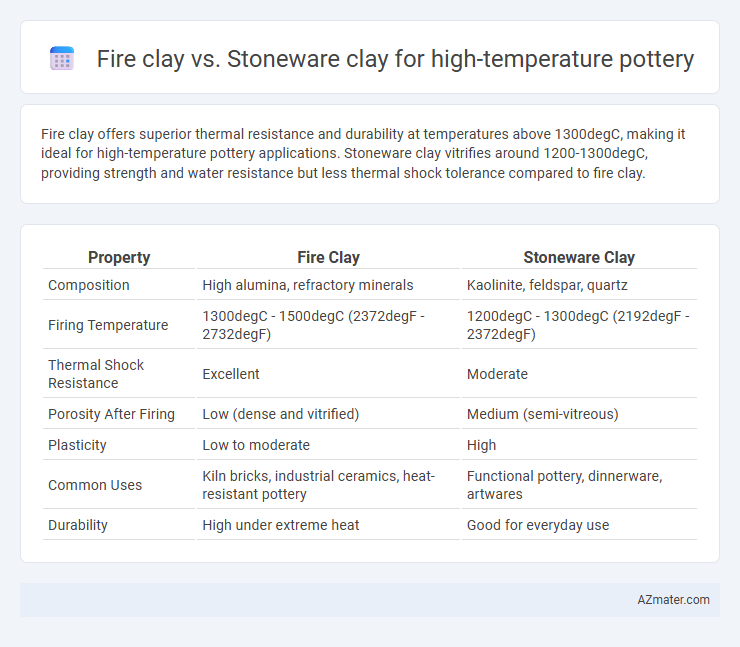Fire clay offers superior thermal resistance and durability at temperatures above 1300degC, making it ideal for high-temperature pottery applications. Stoneware clay vitrifies around 1200-1300degC, providing strength and water resistance but less thermal shock tolerance compared to fire clay.
Table of Comparison
| Property | Fire Clay | Stoneware Clay |
|---|---|---|
| Composition | High alumina, refractory minerals | Kaolinite, feldspar, quartz |
| Firing Temperature | 1300degC - 1500degC (2372degF - 2732degF) | 1200degC - 1300degC (2192degF - 2372degF) |
| Thermal Shock Resistance | Excellent | Moderate |
| Porosity After Firing | Low (dense and vitrified) | Medium (semi-vitreous) |
| Plasticity | Low to moderate | High |
| Common Uses | Kiln bricks, industrial ceramics, heat-resistant pottery | Functional pottery, dinnerware, artwares |
| Durability | High under extreme heat | Good for everyday use |
Introduction to High-Temperature Pottery Clays
High-temperature pottery clays such as fire clay and stoneware clay offer distinct advantages for durability and thermal resistance in kiln firings exceeding 1200degC. Fire clay is known for its high alumina content, providing exceptional heat resistance and structural integrity during intense firing processes. Stoneware clay combines plasticity with strength, producing vitrified, non-porous ceramics that are ideal for both functional and artistic pottery.
What is Fire Clay?
Fire clay is a dense, refractory clay known for its high alumina content and exceptional heat resistance, making it ideal for high-temperature pottery and kiln furniture. It withstands extreme temperatures above 1200degC without cracking or deforming, unlike standard stoneware clay which typically matures at lower temperatures around 1200degC to 1300degC. Fire clay's composition allows potters to create durable, heat-resistant ceramics essential for industrial and artistic applications requiring thermal stability.
What is Stoneware Clay?
Stoneware clay is a durable, vitrified clay fired at high temperatures ranging from 1,200degC to 1,300degC, known for its strength and versatility in pottery. It contains a mix of natural minerals like feldspar, quartz, and kaolin, which contribute to its high firing temperature and dense, non-porous finish. Compared to fire clay, stoneware clay offers superior hardness and is less prone to warping, making it ideal for functional ceramics such as dinnerware and cookware.
Key Properties of Fire Clay
Fire clay is highly valued for its exceptional refractory properties, enabling it to withstand temperatures above 1500degC without deforming or melting, making it ideal for high-temperature pottery and kiln linings. It possesses a high silica and alumina content, contributing to its durability, thermal shock resistance, and low thermal expansion, which prevents cracking during rapid temperature changes. Compared to stoneware clay, fire clay exhibits superior heat resistance and structural stability, essential for producing heatproof ceramic items and industrial refractory products.
Key Properties of Stoneware Clay
Stoneware clay exhibits excellent vitrification and durability at high temperatures, typically firing between 1200degC to 1300degC, making it ideal for functional pottery and dinnerware. Its higher plasticity and lower porosity compared to fire clay result in strong, dense ceramic pieces with good thermal shock resistance. The natural feldspar and quartz content in stoneware clay contributes to its strength, color variation, and ability to develop a smooth, glaze-friendly surface.
Workability and Handling Comparison
Fire clay demonstrates superior workability for high-temperature pottery due to its fine particle size and plasticity, allowing smoother shaping and better detail retention. Stoneware clay, while durable and dense, tends to be less plastic and may require more water or additives for optimal handling, often resulting in a tougher, less nimble feel during forming. Both clays withstand high firing temperatures, but fire clay offers enhanced manipulation ease, making it preferable for intricate or finely crafted pottery pieces.
Firing Temperature Ranges
Fire clay typically fires between 1,200degC and 1,500degC (2,192degF to 2,732degF), making it ideal for high-temperature pottery such as refractories and kiln furniture. Stoneware clay generally matures at slightly lower temperatures, around 1,100degC to 1,300degC (2,012degF to 2,372degF), providing durability and vitrification suitable for functional ware. Selecting the correct clay depends on the specific firing temperature range required for the desired ceramic properties and final use.
Durability and Final Results
Fire clay exhibits superior durability due to its high alumina content, making it ideal for high-temperature pottery with less risk of thermal shock or cracking. Stoneware clay offers a balanced vitrification process, resulting in a dense, non-porous final product that withstands mechanical stress and thermal variations effectively. Both types produce robust pottery, but fire clay excels in extreme heat resistance while stoneware ensures a smoother, more refined finish.
Suitability for Different Pottery Techniques
Fire clay offers excellent thermal shock resistance, making it ideal for coil and slab building techniques used in high-temperature pottery such as wood-fired or gas-fired kilns. Stoneware clay is favored for wheel throwing due to its plasticity and smooth workability, providing consistent results at high firing temperatures between 1200degC and 1300degC. Both clays exhibit durability, but fire clay's grog content enhances rigidity for sculptural forms, while stoneware's finer texture suits detailed surface treatments and glazing.
Which Clay is Best for Your Pottery Project?
Fire clay offers exceptional thermal shock resistance and high vitrification, making it ideal for pottery exposed to extreme temperatures like kiln shelves and flameware. Stoneware clay, while also durable and capable of withstanding high temperatures, provides a smoother texture and is preferred for functional ware such as mugs and plates due to its balance of plasticity and strength. Selecting the best clay depends on your project's requirements: choose fire clay for heavy-duty, heat-intensive applications and stoneware clay for versatile, everyday high-temperature pottery.

Infographic: Fire clay vs Stoneware clay for High-temperature pottery
 azmater.com
azmater.com